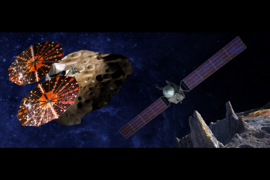Alissa Michelle Earle is rehearsing in front of her class. She stands before a presentation slide, and reads: “Mission Motivation: Apophis is coming!”
“It’s not going to impact Earth but it’s going to come very close to us,” explains Earle, a graduate student in the Department of Earth, Atmospheric and Planetary Sciences.
Apophis is an asteroid the size of an aircraft carrier that will come within 5.5 Earth radii in 2029. As part of 16.83 (Space Systems Engineering), Earle is one of 20 students tasked with designing a space mission to measure the asteroid's internal structure and potential long-term impact hazard.
Professor of planetary sciences Richard Binzel is leading 16.83 with David Miller, the Jerome C. Hunsaker Professor of Aeronautics and Astronautics, who recently returned to MIT after serving as chief technologist for NASA. Inspired by Apophis, the professors teamed up to issue MIT students a challenge: Build a major science robotics mission that marries planetary defense with scientific learning.
The ingenuity of their MIT students soon blew Binzel and Miller away. Early on, the pair advised NASA colleagues of the project and invited their participation in a series of design reviews. As Miller notes, “Both Rick and I have a rolodex at NASA, and as the class progressed, the audience for our reviews grew bigger and bigger.”
Today Binzel and Miller are helping students get ready for a major final review, which will be attended by NASA Headquarters officials and engineers from NASA’s Jet Propulsion Laboratory (JPL). During the trial run, the students are well-prepared but nervous — fidgeting, speed talking, making edits. As Earle speaks, a woman in the audience of students and visiting faculty shouts: “There are a lot of scientific terms you’re using here that we’ve never heard before!”
“You don’t need to get into the specifics right at the beginning,” coaches Binzel, who is one of the world’s top scientists in the study of asteroids and Pluto.
When MIT senior Diego Mundo, an aeronautical and astronautical engineering major, dives into spacecraft instrument design, Binzel interrupts: “Are you sure that will work?”
“I am sure,” says Mundo, who is dressed in a black t-shirt with colored bracelets covering his arms and hair flying out of a ponytail in all directions. But his expression is that of a stern academic as he allows that: “I may not have used the correct words.”
“That’s what today is for,” says Binzel. “You’re getting the feedback to make sure that everything is clear. Let’s go again.”
Space mission
The students want to get their performance and the science just right, since asteroid flyby events on the order of Apophis happen only once about every 1,000 years.
The students' general mission objectives include characterizing the asteroid’s shape, size, density, surface topography, surface composition, rotation rate, and spin state. A NASA spacecraft would have to be launched in August of 2026 to reach the observation position in time. The objective is to get the craft close enough to Apophis to conduct measurements before, during, and after the 2029 event.
Surprisingly, the student-designed mission is the first significant attempt to take on Apophis, which is 350 meters across with a mass of 20 million metric tons. At NASA, Miller says people tend to split into a couple of camps: those in space flight (or the “space cadets,” like him) and the scientists (like Binzel, whom he refers to as an “asteroid hunter extraordinaire”).
Exploration of the hazards posed by asteroids does not quite fit into either camp, Miller says, “so that kind of falls between the cracks at NASA.”
Project Apophis, as Binzel likes to say, is a “kick-starter” — designed to encourage further studies by international space agencies. And for good reason, Miller adds.
“There have been plenty of missions to comets and asteroids, so why is this unique?” he explains. “Apophis is coming so close that Earth’s gravity is going to tug and redirect its path. The Earth is going to give it a big thunk.”
The outcome of that planetary torque will teach scientists more about the construction of asteroids, which were some of the early building blocks of our own solar system. New information could lead to a deeper understanding of the formation of our solar system and the more than 4,000 known planets around other stars. More pragmatically, what we learn from the Apophis encounter could strengthen our knowledge of how to mount a planetary defense in the event an asteroid was ever discovered and verified to be on an impact course.
The big day
On the big day, the room is quiet, and the students are dressed up. Even Mundo appears in a button-up (albeit wrinkled) shirt, with his hair in a tidy bun.
Among the listening experts are NASA Planetary Defense Officer Lindley Johnson, who directs a program for detecting and tracking near-Earth objects; Paul Chodas, who heads the Center for Near-Earth Objects at JPL; and Farah Alibay PhD '14 a JPL systems engineer.
The practice sessions pay off. The students hit a rhythm, and take tough questions as smaller subteams, based on areas of expertise.
“How well do you know the orbit of Apophis after the flyby event?” “Do you have the equipment to change your operation plans if there’s a change in the asteroid?” “Do you know what the rotation vector of the asteroid is?"
The teams don't necessarily have all the answers: “Okay, we can look into that.” “We’ll do the analysis.” “Thanks for the input.”
But the experts are impressed. “It’s a really good effort,” NASA's Johnson says in an encouraging tone. “It’s almost ready for a NASA proposal.”












